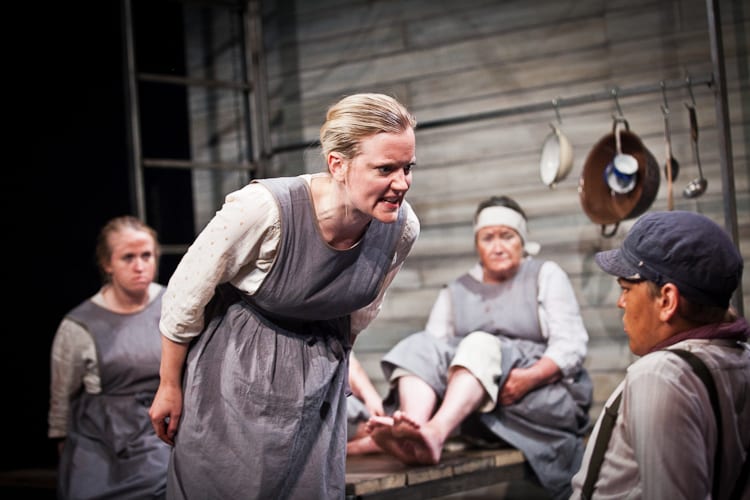There’s been a surge in interest in women’s prison dramas following the success of Netflix series Orange Is The New Black, andFemale Transport takes this focus back to the early 1800s and the women headed to the penal colony of Australia. The play makes use of time jumps to portray the progression of a six month voyage over a couple of hours, and we watch the prisoners’ ties disintegrate, their efforts to retain their dignity and fighting spirit, and their hearts harden. Although the (somewhat gratuitously) expletive-littered dialogue and action would be effective in showing this by itself, the script seems intent on pressing these changes home with several heavy-handed lines in the second half. Generally, Gooch’s writing could do with a little more show not tell – key points are often repeated several times to make sure we understand that, yes, this really is what is happening, and in doing so loses much of the impact. However, it also has its moments: although some amusement is lost in rushed delivery, the dark humour displayed by the prisoners is a real highlight of the piece.
The women are onstage already, Harriet deWinton’s metal frame and simple wooden platforms effectively conjuring up the berths in which they spend the journey. The action begins and ends in this room, and although the women do occasionally leave the room we never leave with them, echoing the sense of their confinement. The metal frame is under-used in terms of creating levels – in the standout scene of the play the young assistant jailer (the endearing Stan Elliott) clambers up a ladder on the outside of the frame and hollers in from the roof – it’s dynamic and visually interesting, and similar moments could do with being repeated elsewhere in the play. Although there is plenty of movement within the cell – there are numerous well-executed fight scenes – scenes dominated by it often feel as if the actors are on tenterhooks waiting to say lines rather than imbuing the wait with any dramatic tension.
This is an amateur performance, helped along by the theatre’s ‘Engage’ program, and many of the actors are making their stage debut, so a little woodenness around the edges is understandable. Emotion often oscillates from fairly surface level to downright hysterical, although the actors seem to settle into their roles as the play progresses. This partly stems from the script itself: the manipulation and politics that is inherent in the interactions between crew and prisoners initially lacks some punch, and although darker themes are addressed there is still a feeling of levity through much of the first act. This does mature in the second half, largely helped by Emily Malloy’s emotive performance as the troubled Pitty – so named after her resemblance to Prime Minister Pitt. The second act is also greatly lifted by a storm scene, easily the high point of the play, where the actors demonstrate the real fear of uncertainty and lack of autonomy as they shout for help and information.
Female Transport does not break boundaries or do anything particularly new – in fact, at times it felt somewhat like it was ticking off a checklist of prison clichés. However, it makes for an entertaining evening and provides roles for a wide range of female actors, which is always refreshing to see. The choral work can be a little rough around the edges, but this rough-hewn sense adds to the overall tone of the piece, fitting in with the thrown-together world these woman inhabit. The strongest moments are those of unified emotion, and, as it ends, you can’t help but wish a little more time had been spent celebrating what brings these women together, rather than what drives them apart.

